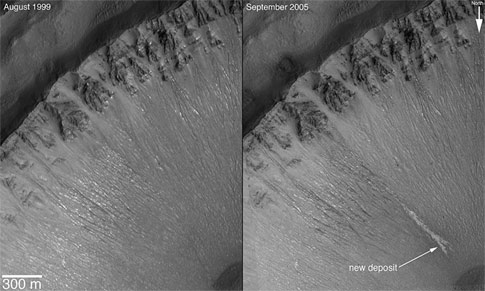Vann på mars
Observations from the Mars Global Surveyor (MGS) have revealed "recent activity" on the surface of the red planet; recent meaning in the past seven years. These changes include cratering from impacts (which is cool enough, and I’ll blog about those later), but also, yes, the flow of water.
Years ago, there were gullies seen on slopes on Mars, and they looked a lot like water had formed them. But it was hard to tell. Now, the evidence is far stronger. For example, check out this image:

This gully is in a crater in the Centauri Montes Region in the martian southern hemisphere. The critical piece of information here is that the gully did not exist in 1999, but is clear in 2005. It’s new!
In the higher resolution images (click it to see them) you can see the gully better. You can tell by eye it certainly looks like a liquid flow.
But how do we know they are water? The context is the key. Gullies indicate the flow of a liquid. Dust avalanches do occur on Mars, but not anywhere near these gullies. The morphology (shape) is important too. See how the gully breaks up as it flows down the slope? That also indicates a fluid flow. Finally, the color is an indicator, too. The light color is difficult to make on Mars. In trenches, most places where the surface dust is disturbed, and impact craters, the underlying layers are always dark. This indicates a different process. Also, numerical calculations using models indicate that whatever caused these gullies flowed like water, not like dust or rocks.
As they say on the Malin Space Science Systems website:
Of course, water was not the only fluid considered by various colleagues; carbon dioxide can be fluid at some pressures and temperatures, and fluid carbon dioxide was also proposed as a candidate fluidizing agent. Even dry mass movement—landsliding—of unconsolidated granular material can exhibit some fluid-like behavior, and such mass movements were considered as an explanation for the gullies.
The presence of channels, primarily formed by erosion—but also displaying features representing along-channel deposition, such as levees and meanders—and terminal depositional aprons consisting of dozens to hundreds of individual flow lobes, contributed to the general acceptance of the hypothesis that gullies involved the action of liquid water.
These bright features in the gullies might be frost, but they’ve been around a while, so that’s pretty unlikely. They might be salts and other minerals deposited by the flow, or they might be smaller sediments carried along with the water.
How much water are we talking about? Maybe 5-10 swimming pools’ worth according to Ken Edgett, the scientist who has been working on these data. It would be a pretty quick flash flood, and, weirdly, in the low atmospheric pressure, the water would be boiling even at the low temperatures of Mars.
So what does this mean? Well, we’ve known of frozen water on Mars for decades, and we know there was activity in the past. These new observations indicate that things are happening on Mars now, within the past few years. And whatever it is that’s happening, it’s releasing water onto the surface, which in turn means that there is water just below the surface of Mars, at least in some places.
Sounds like a good place to build a colony, don’t you think?
It does to me. If there are big deposits of water, then that makes it a lot easier for potential colonists to survive on Mars, "living off the land". While the amount of water in any one gully is small, it indicates more water is nearby. This is terribly exciting.
Now, the skeptic in me must say it: this is not absolute conclusive proof of water on Mars. We need better images (maybe from the new probe orbiting Mars now), and spectra would be nice (to be able to see what chemicals are there). Even better would be to land a rover near there to get samples, though gullies down the sides of crater walls would make a perilous journey for any robot.
If these aren’t water gullies, we’ll all be disappointed, but that’s science. They’ll still be interesting features! But the evidence is very, very compelling, and I certainly hope that NASA follow this up quickly with more observations.
Recent flow of water on Mars from subsurface deposits. Wow.
Bad astronomy

0 Comments:
Post a Comment